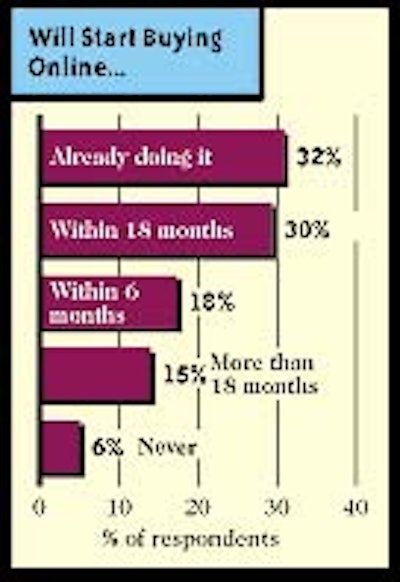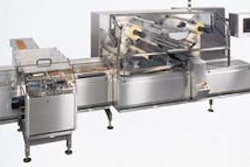Buying packaging products via the Internet has definitely begun. But an exclusive survey conducted on the Packaging World Web site (www.packworld.com) reveals that few respondents are truly distinguishing among all the options they can use.
One question in the survey pointed out a variety of different types of sites (packaging-specific, general industrial, machinery-specific, materials-specific, etc.) and asked respondents their preference and/or if they were concerned about having too many options. The results are clearly mixed, but a high percentage of the respondents seemed to be caught up short by the question.
A packaging employee for a horticultural products marketer said it this way: “I’m not knowledgeable enough to say. I’d need to learn more.” Others were even more distant. A maintenance worker for a major meat processor admitted, “I don’t have any idea how our company plans to deal with the e-marketplace.”
An operations executive with a bakery company admitted ignorance but added, “We will use the Web much like traditional vendors and resources. We will establish relationships with sources that meet our needs and requirements for business interchange.”
The idea of relationships, whether with a vendor or a Web site, was often mentioned by those responding to the survey. Caution comes from a packaging executive for a major tobacco company. “We prefer to buy from established vendors that have been in business for many years. The same with Web sites. Most of the e-sites are not well established, and some are in financial difficulties.”
Favoring vendor sites
Although it could be based only on early experiences, a sizable number of respondents indicated that they liked purchasing through supplier Web sites. An engineering representative from a hardware manufacturer reported that his company “mostly buys direct from suppliers’ [Web sites].” Meanwhile, an engineer with a chemical company said his company plans “to have vendors customize Web-based catalogs for our use.”
An R&D professional at a small food processor was more specific. “I would mostly use the site to gather information on pricing, quantity, availability and other information quickly from the primary vendor,” he says.
“Then, I would still like to talk to someone about ordering it. Once a history with a product and a vendor has been established, I think there would be no problem with simply placing an order online without speaking to a person.”
An engineer with a major national personal care products maker believes that OEM sites “are probably the best, if they keep their sites up-to-date. Equipment spare parts are best purchased from OEMs on their web site.” Responding to the issue of site proliferation, this engineer emphasizes that “My company welcomes this proliferation.”
The vice president of operations for a major maker of food supplements likes two types of Web sites. “Our preference is for individual vendors so that we maintain relationships and our competitive position, while we take advantage of the efficiencies of Web commerce. Secondly, we would work with industry-specific consortiums, but only if the right vendors agree to join.”
Despite the fact that respondents obviously use the Web, more than a few admit their companies are still not into e-procurement. An executive with a chemicals manufacturer sees Internet purchasing only in the future. “I do not foresee my company participating in this type of procurement. Possibly [it may happen] in the future, when our IS department sets up specific requirements.” An R&D executive with a major national fast-food chain says, “My company would buy from vendors, but most are not on the Web.”
Some show sophistication
In contrast to those participants whose companies haven’t begun to buy via the Web, many others’ comments reveal a great deal of energy and experience with Web purchasing.
“I suspect we will end up choosing one or two of the many sites that will be available,” reports a packaging executive with a motorcycle manufacturer. “We’ll have to wade through the garbage to get what we want. We are discussing supplier access to our system for supplier-managed inventory and purchasing. That would partner us with suppliers over time, and eliminate [the need for] frequent ‘shopping.’”
A purchasing official for a maker of safety products explains how her company will use the Web. “The initial step may be to buy direct from existing suppliers through their Web sites, or we may set up a direct internal system between our company and the supplier.”
A purchasing executive for a maker of cabinets has a similar plan. “We would set up major suppliers on our internal system, and go to material- or machinery-specific sites for less frequent or for smaller purchases.”
On the other hand, a packaging official for a maker of nutraceuticals says his company is reluctant to bring suppliers into its in-house purchasing system. “We would prefer to keep the vendors out of our internal systems, while we remain proactive in our own approaches to [Internet] procurement.”
Other preferences
Some respondents seized on other choices but few explained their decisions. A marketing executive with an industrial chemicals manufacturer says her preference varies, depending on the value of the purchase. “We typically buy through industry-specific sites on large ticket products,” she says. “For smaller purchases, we generally buy through distributors where we can select from a variety of products.”
An industrial manufacturer may have summed up the feelings of many. “Different sites will have different strengths,” this plant manager says. “Close-out sites will do a better job of moving close-out merchandise, for example. We believe sites will be shopped for the best pricing and most effective systems.”
A maintenance executive with a pharmaceutical manufacturer sees generalized sites for certain types of purchases. “We’d prefer to locate a site that will allow us compare parts, like motors, gearboxes, drives, seals and bearings. Then we’d like another site that dealt with pneumatic parts and another for conveying equipment parts.”
The packaging development manager for a maker of outdoor leisure products reports his company is just getting into Web procurement. “Right now, we buy some small maintenance and office-type products,” he says. “But when it comes to the main packaging components, it will probably take some time before we reach the ‘comfort zone.’”
A number of respondents reported that the packaging materials they buy are custom converted and thus really didn’t qualify for putting it out to bid. A purchasing official for a food processor noted: “The materials I buy are very specific for my products. Therefore, I would prefer to buy directly from my vendors. Web sites that provide, say, general boxes, would not apply to my process. My company uses highly specified, custom-made corrugated containers that I couldn’t procure from a general site.”
While we did not include the responses from packaging suppliers in this report, a president of one packaging distributor recognized the threat to his company’s business. “These Web sites are a major problem for sellers of commodity products, because buyers simply shop for the lowest price. From a distributor viewpoint, it also blurs territorial boundaries. We don’t see users purchasing expensive or complicated equipment via e-procurement.”
He continued: “We have to make sure that our suppliers’ Web sites are easy to find and informative, because in our experience, packagers mainly use the Web to research equipment and then they call us in for the personal touch and for more specific information that relates to their particular requirements. If a manufacturer’s site is weak or hard to find, we could lose a potential customer. And we also have to make sure that the manufacturer’s site makes it easy for a customer to find the local distributor.”


























